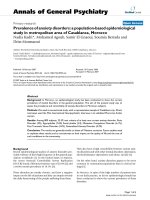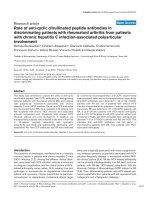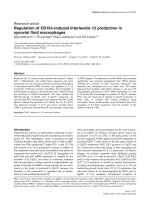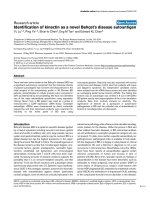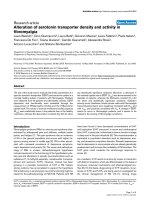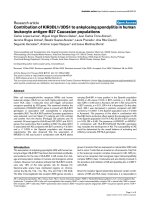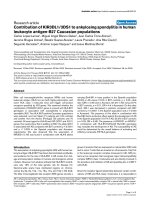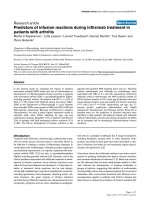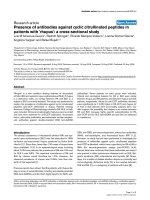Báo cáo y học: "Screening of an endothelial cDNA library identifies the C-terminal region of Nedd5 as a novel autoantigen in systemic lupus erythematosus with psychiatric manifestations" ppt
Bạn đang xem bản rút gọn của tài liệu. Xem và tải ngay bản đầy đủ của tài liệu tại đây (813.86 KB, 8 trang )
Open Access
Available online />R896
Vol 7 No 4
Research article
Screening of an endothelial cDNA library identifies the C-terminal
region of Nedd5 as a novel autoantigen in systemic lupus
erythematosus with psychiatric manifestations
Paola Margutti
1
, Maurizio Sorice
2
, Fabrizio Conti
3
, Federica Delunardo
1
, Mauro Racaniello
1
,
Cristiano Alessandri
3
, Alessandra Siracusano
1
, Rachele Riganò
1
, Elisabetta Profumo
1
,
Guido Valesini
3
and Elena Ortona
1
1
Dipartimento di Malattie Infettive, Parassitarie e Immunomediate, Istituto Superiore di Sanità, Rome, Italy
2
Dipartimento di Medicina Sperimentale e Patologia, Cattedra di Reumatologia, Università 'La Sapienza', Rome, Italy
3
Dipartimento di Clinica e Terapia Medica Applicata, Cattedra di Reumatologia, Università 'La Sapienza', Rome, Italy
Corresponding author: Elena Ortona,
Received: 23 Dec 2004 Revisions requested: 20 Jan 2005 Revisions received: 22 Mar 2005 Accepted: 18 Apr 2005 Published: 20 May 2005
Arthritis Research & Therapy 2005, 7:R896-R903 (DOI 10.1186/ar1759)
This article is online at: />© 2005 Margutti et al.; licensee BioMed Central Ltd.
This is an Open Access article distributed under the terms of the Creative Commons Attribution License ( />2.0), which permits unrestricted use, distribution, and reproduction in any medium, provided the original work is properly cited.
Abstract
Anti-endothelial-cell antibodies are associated with psychiatric
manifestations in systemic lupus erythematosus (SLE). Our
primary aim in this study was to seek and characterize molecules
that behave as endothelial autoantigens in SLE patients with
psychiatric manifestations. By screening a cDNA library from
human umbilical artery endothelial cells with serum from an SLE
patient with psychosis, we identified one positive strongly
reactive clone encoding the C-terminal region (C-ter) of Nedd5,
an intracytoplasmatic protein of the septin family. To evaluate
anti-Nedd5 serum immunoreactivity, we analyzed by ELISA
specific IgG responses in 17 patients with SLE and psychiatric
manifestations (group A), 34 patients with SLE without
psychiatric manifestations (group B), 20 patients with systemic
sclerosis, 20 patients with infectious mononucleosis, and 35
healthy subjects. IgG specific to Nedd5 C-ter was present in 14
(27%) of the 51 SLE patients. The mean optical density value for
IgG immunoreactivity to Nedd5 C-ter was significantly higher in
patients of group A than in those of group B, those with
infectious mononucleosis, or healthy subjects (0.17 ± 0.14 vs,
respectively, 0.11 ± 0.07, P = 0.04; 0.11 ± 0.06, P = 0.034;
and 0.09 ± 0.045, P = 0.003, on Student's t-test). Moreover,
IgG immunoreactivity to Nedd5 C-ter was significantly higher in
patients with systemic sclerosis than in patients of group B or
healthy subjects (0.18 ± 0.18 vs, respectively, 0.11 ± 0.07, P =
0.046; and 0.09 ± 0.045, P = 0.003). The percentage of
patients with anti-Nedd5 C-ter serum IgG was higher in group A
than in group B (8 (47%) of 17, vs 6 (17%) of 34, P = 0.045,
on Fisher's exact test). In order to clarify a possible mechanism
by which Nedd5 might be autoantigenic, we observed that
Nedd5 relocated from cytoplasm to the plasma membrane of
EAhy926 endothelial cells after apoptotic stimuli. In conclusion,
Nedd5 is a novel autoantigen of potential clinical importance
that could be successfully used for a more thorough
investigation of the pathogenesis of psychiatric manifestations
in SLE. Although anti-Nedd5 autoantibodies are not specific to
SLE, they are significantly associated with neuropsychiatric SLE
and may represent immunological markers of psychiatric
manifestations in this pathology.
Introduction
Symptoms originating from the central nervous system occur
in 14 to 75% of patients with systemic lupus erythematosus
(SLE) and are extremely diverse, including neurological and
psychiatric syndromes [1]. In 1999, the American College of
Rheumathology defined 19 distinct neuropsychiatric syn-
dromes associated with SLE, including psychosis and depres-
sion [2,3]. Neuropsychiatric SLE remains an enigmatic
manifestation in lupus. In fact, conflicting results have been
reported to clarify associations between neuropsychiatric
AECA = anti-endothelial-cell antibody; BSA = bovine serum albumin; C-ter = C-terminal region; ELISA = enzyme-linked immunosorbent assay; FITC
= fluorescein isothiocyanate; HUAEC = human umbilical artery endothelial cell; OD = optical density; PBS = phosphate-buffered saline; SD = stand-
ard deviation; SLE = systemic lupus erythematosus; SLEDAI = SLE Disease Activity Index; TNF-α = tumor necrosis factor α.
Arthritis Research & Therapy Vol 7 No 4 Margutti et al.
R897
manifestations and serum antibodies against neuronal anti-
gens, ribosomes, and phospholipids [4]. Recently, we demon-
strated an association between the presence of anti-
endothelial-cell antibodies (AECAs) and psychiatric manifes-
tations, such as psychosis and depression in SLE, suggesting
a possible mechanism underlying psychiatric symptoms [5].
By activating endothelial cells, AECAs up-regulate the expres-
sion of adhesion molecules as well as the secretion of
cytokines and chemokines. Until recently, few published data
have been available on the identity of endothelial cell autoanti-
gens in immune disorders [6-11]. Identifying endothelial
autoantigens involved in the autoimmune processes during
neuropsychiatric SLE could help to explain the pathogenetic
mechanisms involved in the initiation and progression of psy-
chiatric symptoms.
Our primary aim in this study was to seek and characterize
molecules that behave as endothelial autoantigens in neu-
ropsychiatric SLE. By screening a cDNA library from human
umbilical artery endothelial cells (HUAECs) with serum from
an SLE patient with psychosis, we identified one strongly reac-
tive clone encoding the C-terminal region (C-ter) of Nedd5, an
intracytoplasmatic protein of the septin family. To evaluate anti-
Nedd5 serum immunoreactivity, we used ELISA to measure
specific IgG responses in patients with SLE classified accord-
ing to the presence of psychiatric manifestations, such as psy-
chosis and depression. Data were compared with those of
patients with systemic sclerosis (an autoimmune disease char-
acterized by endothelium damage and the presence of
AECAs), of patients with infectious mononucleosis, and of
healthy subjects. Finally, we investigated by immunofluores-
cence the intracellular redistribution of Nedd5 in endothelial
cells after apoptotic stimuli.
Materials and methods
Patients
For the present investigation, we studied sera from an SLE
cohort of 51 outpatients attending the Rheumatology Division
of the University of Rome 'La Sapienza'. All patients were diag-
nosed according to the American College of Rheumatology
revised criteria for the classification of SLE [2]. This population
of SLE patients had been previously characterized with regard
to their psychiatric and autoantibody profiles [5]. For our
present purposes, we studied 50 of the 51 sera, because the
serum from one SLE patient with mood disorder had run out.
In this study, we also included the serum from a patient seen
in the meantime with SLE and acute psychosis, a very rare
manifestation of neuropsychiatric SLE.
Patients were categorized as being in group A or group B on
the basis of the clinical psychiatric examination, which was
performed by means of the Structured Clinical Interview for
Psychiatric Diagnosis [12]. A psychiatric diagnosis was
assigned according to the Diagnostic and Statistical Manual
of Mental Disorders IV [13]. Group A consisted of patients
with psychosis (n = 3) and mood disorders (n = 14). Group B
included patients without psychiatric manifestations (n = 18)
and patients whose only psychiatric manifestation was anxiety
disorder (n = 16). We did not include patients with anxiety dis-
turbance in group A, because in most SLE patients anxiety is
considered a secondary stress reaction and not a direct man-
ifestation of neuropsychiatric SLE [5].
Current SLE disease activity was measured using the SLE
Disease Activity Index (SLEDAI). We also studied as controls
sera from 35 sex- and age-matched healthy subjects; 20 sera
from patients with systemic sclerosis (18 female, 2 male; mean
age 53 years, range 27 to 72) attending the Rheumatology
Division of the University of Rome 'La Sapienza'; and 20 sex-
and age-matched patients with infectious mononucleosis from
the Department of Experimental Medicine and Pathology of
the University of Rome 'La Sapienza'. Informed consent was
obtained from each patient, and the local ethics committee
approved the study protocol. The sera were stored at -20°C
until they were assayed.
Immunoscreening of the cDNA expression library
A commercially available HUAEC cDNA library (Stratagene,
Cambridge, UK) was used to screen for clones showing immu-
noreactivity with a serum from a patient with SLE, acute and
active psychosis, and elevated titer of serum AECA. The
expression library was screened essentially as previously
described [14]. The serum was diluted 1:350 in PBS contain-
ing 1% milk and 0.05% Tween-20 and supplemented with
0.02% sodium azide. To reduce nonspecific binding to
Escherichia coli (XL1-Blue MRF') (Stratagene) and phage
vector, diluted pool was preadsorbed three times on nonre-
combinant phage plaques. For primary immunoscreening, the
library was plated out at 12,500 plaque-forming units per 140-
mm plate, using XL1-Blue MRF' host cells in accordance with
the supplier's instructions. In brief, nitrocellulose filters, incu-
bated with 10 mM isopropyl β-D-1-thiogalactopyranoside
(Sigma-Aldrich, St Louis, MO, USA) were overlaid onto the
plates and incubated for 4 hours at 37°C. After blocking in 5%
milk/PBS, the filters were incubated with the preadsorbed
serum overnight at room temperature. After four washes with
0.05% PBS, Tween-20 membranes were incubated with a
1:3000 dilution of goat antihuman IgG (Bio-Rad, Richmond,
CA, USA) in PBS containing 0.05% Tween-20 and 1% milk
for 3 hours at room temperature. After a final four washes in
0.05% PBS Tween-20, membranes were incubated for 20
min with diaminobenzidine substrate (Sigma-Aldrich). Plaques
corresponding to immunoreactive regions were cored from the
original plate and resuspended in suspension medium con-
taining 10 µl chloroform. Positive plaques were rescreened
with the same serum to obtain the clonality.
Cloned phage showing immunoreactivity was recovered as
pBluescript by single-stranded rescue using the helper phage
(Stratagene) according to the supplier's instructions and used
Available online />R898
to transform SolR XL1cells. The nucleotide sequence of the
cloned cDNA insertion was sequenced with automated
sequencer ABI Prism 310 Collection (Applied Biosystems,
Foster City, CA, USA) and sequences were then compared
with the GenBank sequence database using both Fasta and
Blast analysis [15,16]. To predict coiled-coil domain, we used
the appropriate software />COILS_form.html.
Expression and purification of the recombinant antigen
The selected cDNA clone was subcloned into the Bam HI/
HindIII restriction site of the QIA express vector, pQE30. To
obtain the whole molecule of Nedd5, we amplified the cDNA
of the library using specific primers designed from the 5' and
3' termini of sequence obtained in GenBank (accession
number BC033559) with Bam HI/HindIII restriction site and
cloned in the expression vector.
The fusion protein was expressed in Escherichia coli
SG130009 cells, purified by affinity of NI-NTA resin for the 6X
histidine tag and eluted under denaturing conditions (urea) in
accordance with the supplier's instructions (Qiagen, Hilden,
Germany). After purification, urea was removed by dialysis in
PBS with decreasing concentrations of urea, with a last
change of PBS alone overnight at 4°C. Protein concentration
was determined by the Bio-Rad Bradford protein assay (Bio-
Rad).
Indirect immunofluorescence assay
Hep-2 cells were directly stained with the mouse anti-Nedd5
polyclonal antiserum, obtained by standard immunization pro-
tocol, or with the corresponding mouse preimmune serum, in
PBS containing 1% BSA. After washing three times with PBS,
fluorescein-isothiocyanate (FITC)-conjugated antimouse IgG
(γ-chain specific) (Sigma) were then added and incubation
was at 4°C for 30 min.
Alternatively, EAhy926 human vascular endothelial cells [17]
were grown to 60 to 70% confluence and seeded at 5 × 10
6
per well on glass cover slips. Cells, either untreated or treated
with 20 ng/ml of tumor necrosis factor α (TNF-α) and 10 µg/
ml of cycloheximide for 16 hours [18], were fixed with 4% for-
maldehyde in PBS for 30 min at 4°C. Alternatively, cells were
permeabilized with acetone:methanol 1:1 (vol:vol) for 10 min
at 4°C and then soaked in balanced salt solution (Sigma) for
30 min at 25°C. Cells were then incubated for 30 min at 25°C
in the blocking buffer (2% bovine serum albumin in PBS, con-
taining 5% glycerol and 0.2% Tween-20). Apoptosis was eval-
uated by propidium iodide staining, according to the method
of Nicoletti and colleagues [19], and by the binding of FITC-
conjugated Annexin V, using the Apoptest binding kit, contain-
ing annexin V-FITC and binding buffer. After washing three
times with PBS, cells were incubated for 1 hour at 4°C with
the mouse anti-Nedd5 polyclonal antiserum, obtained by
standard immunization protocol, or with the corresponding
mouse preimmune serum, in PBS containing 1% BSA. FITC-
conjugated antimouse IgG (γ-chain specific) (Sigma) were
then added and incubated at 4°C for 30 min. After washing
with PBS, fluorescence was analyzed with an Olympus U RFL
microscope (Olympus, Hamburg, Germany).
SDS–PAGE and immunoblotting
Immunoblotting, after 12% SDS–PAGE under reducing con-
ditions, was performed as previously described [20]. In brief,
Nedd5 C-ter was used as antigen at the concentration of 3
µg/lane and was revealed by human sera diluted 1:100, by a
monoclonal antibody specific to six-histidine tail (Qiagen), or
by the mouse polyclonal antiserum (1:200). Goat antihuman
and antimouse IgG-labelled sera (Bio-Rad) were used as sec-
ond antibodies. Strips were developed with peroxidase sub-
strate, 3-3' -diaminobenzidine (Sigma). EAhy926 endothelial
cells were harvested by mechanical scraping and centrifuged
at 10,000 g for 30 min and the pellet was resuspended in the
loading buffer under reducing conditions, boiled for 10 min,
and loaded (100,000 cells/well) in a 10.5% SDS-polyacryla-
mide gel. After immunoblotting, the mouse polyclonal antise-
rum and the corresponding mouse preimmune serum were
used to reveal the presence of Nedd5 in the cell preparation.
ELISA
ELISA for specific total IgG was developed essentially as pre-
viously described [14]. In brief, polystyrene plates (Dynex, Ber-
lin, Germany) were coated with Nedd5 C-ter 0.5 µg/well in
0.05 µM NaHCO
3
buffer, pH 9.5. Coated plates were incu-
bated overnight at 4°C and then washed three times with PBS
containing 0.05% Tween-20 in an automated washer (Well-
wash 4, Labsystem, Turku, Finland). Plates were blocked with
PBS Tween containing 3% gelatin (Bio-Rad), 100 µl/well, for
1 hour at room temperature and washed as previously
described. Human sera were diluted in PBS Tween-20 and
1% gelatin (1:100 for total IgG) and pipetted onto plates at
100 µl per well. Plates were incubated for 1 hour at 20°C and
washed as described. Peroxidase-conjugated goat antihuman
IgG (Bio-Rad) was diluted 1:3000 in the same buffer. These
dilutions were used as second antibodies and incubated (100
µl/well) for 1 hour at 20°C. o-Phenylenediamine dihydrochlo-
ride (Sigma) was used as a substrate and absorbance was
measured at 490 nm. Means + 2 standard deviations (SD) of
the absorbance reading of the healthy controls were consid-
ered the cutoff levels for positive reactions. All assays were
performed in quadruplicate. Data were presented as the mean
optical density (OD) corrected for background (wells without
coated antigen). The results of unknown samples on the plate
were accepted if internal controls (two serum samples, one
positive and one negative) had an absorbance reading within
mean ± 10% of previous readings. To inhibit specific IgG, the
sera from three patients with SLE, anti-Nedd5 C-ter IgG posi-
tive, were diluted 1:50 in PBS-Tween and were incubated
overnight at room temperature in 10 µg/ml of Nedd5 C-ter
according to the method reported by Huang and colleagues
Arthritis Research & Therapy Vol 7 No 4 Margutti et al.
R899
[21]. As a negative control, the sera were pre-incubated with
40 µg/ml of BSA.
Cultures of human umbilical-vein-derived endothelial cells at
the third to fourth passage were used to detect AECA (IgG),
using a cell-surface ELISA on living cells, as previously
reported [5]. AECAs were expressed as binding index (BI)
equal to 100 × (S-A) / (B-A), where S is the OD of the sample
tested, A is the OD obtained with only the secondary antibody,
and B the OD of a positive reference serum. AECAs were con-
sidered positive when BI was higher than the cutoff value
(mean+2 SD of 66 healthy controls) corresponding to 50% of
a positive reference serum from a patients with SLE. Antibod-
ies against cardiolipin, β2 glycoprotein I, Ro/SSA, Ro/SSA 52,
La/SSB, glial fibrillary acidic protein, ribosomal P protein, and
nucleosome IgG were tested as previously described [5]
Statistical analysis
Unless otherwise specified, all values are means ± SD. The
Fisher exact test and χ
2
analysis were used to evaluate differ-
ences between percentages; Student's t-test was used to
evaluate differences between arithmetic means. P values less
than 0.05 indicated statistically significant differences.
Results
Immunoscreening of HUAEC expression library
Immunoscreening of the HUAEC expression library with IgG
from the serum of a patient with SLE and active psychosis
identified a strongly reactive clone. The amino acid sequence,
predicted from the 335-base-pair open reading frame of this
clone, is 109 residues long and has 100% identity with the C-
terminal subunit of Nedd5, a protein of the septin family (Fig.
1a,b). The search for possible coiled-coil domains in the data-
base disclosed a coiled-coil domain in this amino acid region.
Because preliminary experiments showed that the whole mol-
ecule and the C-terminal subunit gave equivalent serological
results (data not shown), in serological tests we used the C-
terminal subunit (Nedd5 C-ter), which contains the immunore-
active epitopes. The molecular size predicted from the amino
acid sequence of 13.6 kDa, the purity, and the immunoreactiv-
ity of the expressed recombinant protein was confirmed by
12% SDS–PAGE and immunoblotting (Fig. 1c).
ELISA for anti-Nedd5 C-ter IgG
IgGs specific to Nedd5 C-ter in ELISA were present in 14
(27.4%) of 51 SLE patients and did not correlate with the
presence of AECAs previously studied in the same population
of patients [5]. Moreover, no significant correlation was found
between the presence of anti-Nedd5-C-ter IgG and the pres-
ence of antibodies against cardiolipin, β
2
glycoprotein I, Ro/
SSA, Ro/SSA52, La/SSB, glial fibrillary acidic protein, ribos-
omal P protein, or nucleosome IgG (data not shown). To
assess the specificity of ELISA, we preadsorbed sera from
three SLE patients positive to Nedd5 C-ter with Nedd5 C-ter
itself, and we observed a complete inhibition of reactivity (data
not shown).
The mean OD value for IgG immunoreactivity to Nedd5 C-ter
was significantly higher in patients of group A than in those of
group B, those with infectious mononucleosis, or healthy sub-
jects (0.17 ± 0.14 vs, respectively, 0.11 ± 0.07, P = 0.04;
0.11 ± 0.06, P = 0.034; 0.09 ± 0.045, P = 0.003, on Stu-
dent's t-test). Moreover, IgG immunoreactivity to Nedd5 C-ter
was significantly higher in patients with systemic sclerosis
than in patients of group B or in healthy subjects (0.18 ± 0.18
vs, respectively, 0.11 ± 0.07, P = 0.046; and 0.09 ± 0.045, P
= 0.003) (Fig. 2). The percentage of patients with anti-Nedd5
C-ter serum IgG was higher in group A than in group B (8
Figure 1
Nucleotide and amino acid sequences and immunochemical character-ization of the C-terminal region of Nedd5Nucleotide and amino acid sequences and immunochemical character-
ization of the C-terminal region of Nedd5. (a) The nucleotide sequence
of 335 base pairs of the cloned cDNA insertion was sequenced with
automated sequencer ABI Prism 310 Collection. (b) The amino acid
sequence predicted from the nucleotide sequence is 109 residues
long. The sequence compared with the GenBank sequence database
using both Fasta and Blast analysis has 100% identity with the C-termi-
nal subunit of Nedd5 (accession number Q15019). (c) The molecular
size and the purity of the expressed protein were confirmed by 12%
SDS–PAGE stained by Coomassie blue (lane 1). Immunoreactivity was
analyzed by immunoblotting: monoclonal antibody antihistidine tail (lane
2); mouse polyclonal antiserum specific to Nedd5 C-ter (lane 3); repre-
sentative sera from three patients with SLE IgG positive to Nedd5
(lanes 4,5,6); representative serum from a patient with SLE IgG nega-
tive to Nedd5 C-ter (lane 7); representative serum from a healthy sub-
ject (lane 8); control lane without serum (lane 9).
Available online />R900
(47%) of 17, vs 6 (17%) of 34, P = 0.045 on the Fisher exact
test). No correlation was observed between the presence of
anti-Nedd5 C-ter antibodies and clinical features of SLE or
SLEDAI (Table 1).
Localization of Nedd5 in HEp-2 cells and in EAhy926 cells
We analyzed primarily the localization of Nedd5 in HEp-2 cells,
a conventional cell line used in clinical laboratories because of
their active proliferation. As expected, the immunolabelling
with a mouse polyclonal antiserum specific to the recombinant
Nedd5 C-ter appeared confined to the cytoplasm, where
staining of the contractile ring was evident. No staining was
Figure 2
Anti- Nedd5 C-ter antibodies in patients with SLE with and without psychiatric manifestationsAnti- Nedd5 C-ter antibodies in patients with SLE with and without psychiatric manifestations. Dot plot of anti-Nedd5 C-ter IgG in systemic lupus
erythematosus (SLE) patients with psychiatric manifestations (group A, n = 17), in SLE patients without psychiatric manifestations other than anxiety
(group B, n = 34), in systemic sclerosis (SSc) patients (n = 20), and in patients with infectious mononucleosis (n = 20). Each dot represents a sub-
ject. The samples were considered positive when their optical density was higher than the cutoff value (mean + 2 SD for 35 healthy controls). The
broken line represents the cutoff (0.18). *Group A vs group B, P = 0.04; #group A vs infectious mononucleosis, P = 0.034; °group A vs healthy con-
trols, P = 0.003; ^SSc patients vs group B, P = 0.046; §SSc patients vs healthy controls, P = 0.003 (Student's t-test).
Table 1
Clinical characteristics of SLE patients according to psychiatric symptoms and anti-Nedd5 C-ter IgG
Group A
a
(n = 17) Group B
a
(n = 34)
Characteristic Anti-Nedd5 C-ter IgG (n = 8) No anti-Nedd5 C-ter IgG (n = 9) Anti-Nedd5 C-ter IgG (n = 6) No anti-Nedd5 C-ter IgG (n = 28)
Age (y), mean (range) 38.6 (26–52) 37.1 (23–50) 34.5 (28–48) 37.2 (14–70)
Sex (males/females) 1/7 2/7 1/5 3/25
Disease duration (y), mean (range) 11.2 (7–21) 6.8 (0.5–19) 9 (5–15) 12.1 (0.5–24)
Arthritis, no. (%) 5 (62.5) 9 (100) 5 (83.3) 18 (64.2)
Neurological involvement, no. (%) 2 (25) 4 (44.4) 2 (33.3) 11 (39.2)
Renal involvement, no. (%) 3 (37.5) 0 3 (50) 9 (32.1)
Cytopenia, no. (%) 5 (62.5) 7 (77.7) 4 (66.6) 16 (57.1)
Serositis, no. (%) 2 (25) 2 (22.2) 2 (33.3) 8 (28.5)
SLEDAI >3, no. (%) 5 (62.5) 4 (44.4) 4 (66.6) 12 (42.8)
a
Group A, patients with depression or psychosis; group B, patients without psychiatric manifestations other than anxiety. Differences between the
groups as measured by the χ
2
test were not statistically significant. SLE, systemic lupus erythematosus; SLEDAI, Systemic Lupus Erythematosus
Disease Activity Index.
Arthritis Research & Therapy Vol 7 No 4 Margutti et al.
R901
observed on the cell surface (Fig. 3a). In contrast, no staining
with the mouse preimmune serum was observed, indicating
that the immunolabelling was specific for Nedd5 C-ter (data
not shown).
Immunoblotting of EAhy926 cells, revealed with the mouse
polyclonal antiserum specific to the recombinant Nedd5 C-ter,
showed a single band corresponding to the native Nedd5 pro-
tein at the expected molecular size of 42 kDa deduced from
the amino acid sequence (Fig. 3b).
We analyzed Nedd5 relocation to the plasma membrane of
EAhy926 cells during apoptosis, by immunofluorescence
assay with the mouse polyclonal antiserum anti-Nedd5 C-ter
(Fig. 3c). Untreated cells showed virtually no staining on the
plasma membrane (i). On the contrary, an uneven surface dis-
tribution of anti-Nedd5 staining was observed in cells treated
with TNF-α plus cycloheximide (ii). These findings were con-
firmed in permeabilized cells. Indeed, untreated control cells
showed anti-Nedd5 staining confined to the cytoplasm, with
pronounced perinuclear granularity and without significant
staining of the cell surface (iii). Induction of apoptosis by treat-
ment with TNF-α plus cycloheximide changed the cellular dis-
tribution of Nedd5, with an uneven surface distribution of the
staining that appeared in the cytoplasm and around plasma
membrane (iv). No staining with the mouse preimmune serum
was observed in any of the samples, indicating that the
observed immunolabelling was specific for Nedd5. Apoptosis
was checked by testing the exposure of phosphatidylserine on
the cell surface by the binding of FITC-conjugated Annexin V,
which revealed that up to 80% of the cells were positive (data
not shown).
Discussion
In this study, we used a molecular cloning strategy to identify
endothelial autoantigens in SLE patients. Results provide evi-
dence that the C-terminal region of Nedd5 is a novel autoanti-
gen with a role in neuropsychiatric manifestations. Nedd5 is a
mammalian septin known to associate with actin-based struc-
tures such as the contractile ring and stress fibers [22,23].
The septins are a family of cytoskeletal GTPases that play an
essential role in cytokinesis in yeast and mammalian cells [24].
Nedd5 is predominantly expressed in the nervous system and
may contribute to the formation of neurofibrillary tangles as
integral constituents of paired helical filaments in Alzheimer's
disease [25,26].
To our knowledge, this is the first report describing an immune
response against a protein of the septin family. This study pro-
vides evidence that Nedd5 molecules are expressed on the
cell surface after apoptotic stimuli, suggesting a possible
mechanism by which Nedd5 may be autoantigenic. Indeed,
apoptosis may play an important role in bypassing tolerance to
intracellular autoantigens. The specific modification of autoan-
tigens and their redistribution into blebs at the surface of
apoptotic cells may contribute to the induction of autoimmune
responses [27,28]. Moreover, apoptotic defects and impaired
removal of apoptotic cells could contribute to an overload of
autoantigens in the circulation or in target tissues that could
become available to initiate an autoimmune response [29]. In
susceptible individuals, this can lead to autoantibody-medi-
ated tissue damage.
Interestingly, the C-terminal region of Nedd-5 displays a
coiled-coil domain. Several autoimmune autoantigens are
characterized by the presence of such a domain [30]. Coiled-
Figure 3
Localization of Nedd5 in HEp-2 cells and in EAhy926 cellsLocalization of Nedd5 in HEp-2 cells and in EAhy926 cells. (a) Immun-
ofluorescence analysis of Nedd5 localization in HEp-2 cells. The mouse
polyclonal antiserum specific to Nedd5 C-ter was used to analyze the
cellular distribution of Nedd5. (b) 10.5% SDS–PAGE and immunoblot-
ting of EAhy926 cells. EAhy926 cells were centrifuged and the pellets
were redissolved in the loading buffer under reducing conditions
(100,000 cells/well). 10.5% SDS–PAGE stained by Coomassie blue
(1); immunoblotting was performed with the mouse polyclonal antise-
rum specific to Nedd5 C-ter (2) and with the mouse preimmune serum
(3). (c) Immunofluorescence analysis of Nedd5 localization in endothe-
lial cells under physiological conditions and during apoptosis. EAhy926
cells were treated with tumor necrosis factor α (TNF-α) (20 µg/ml) plus
cycloheximide (10 µg/ml) for 16 hours to induce apoptosis. The mouse
polyclonal antiserum specific to Nedd5 C-ter was used to analyze the
cellular distribution of Nedd5. (i) Untreated cells, fixed with 4% formal-
dehyde in PBS; (ii) TNF-α plus cycloheximide-treated cells, fixed with
4% formaldehyde in PBS; (iii) untreated cells, permeabilized with ace-
tone:methanol 1:1 (vol:vol); (iv) TNF-α plus cycloheximide-treated cells,
permeabilized with acetone : methanol 1:1 (vol:vol).
Available online />R902
coil proteins may be exposed to the immune system as surface
structures in aberrant disease states associated with unregu-
lated cell death and could become autoimmune targets [30].
Even though in this study we used an endothelial cDNA
expression library and we screened it with a serum with an ele-
vated AECA titer, we found no significant correlation between
the presence of AECAs and the presence of anti-Nedd5 anti-
bodies in patients with SLE (data not shown). This finding is
not surprising, since the cell-surface ELISA on living cells used
to detect AECAs reveals only plasma membrane antigens,
whereas Nedd5, which is normally confined within the cyto-
plasm, becomes exposed on the cell surface after triggering
apoptosis. Interestingly, we found such antibodies in a large
proportion of patients with systemic sclerosis, a pathology in
which endothelial damage may often occur. However, we can-
not exclude the possibility that the autoimmune response we
observed was generated against Nedd5 present in other cel-
lular compartments, such as the nervous system.
An association between serum AECAs and psychosis or
depression in patients with SLE has been recently reported,
strengthening the view of a possible implication of AECAs in
the development of psychiatric disorders in SLE [5]. In this
study, attempting to identify a possible molecular target of
AECAs in an SLE patient with active psychosis, analyzing the
same population of patients as in the previous investigation
[5], we demonstrated an association between serum IgG spe-
cific to the C-terminal region of Nedd5 and psychiatric mani-
festations in patients with SLE. Notably, all of the three
patients with psychosis had serum IgG to Nedd5 C-ter. Over-
all, although anti-Nedd5 autoantibodies are not specific to
SLE, they are significantly associated with neuropsychiatric
SLE and could be immunological markers of psychiatric mani-
festations in this pathology. The unanswered question is
whether anti-Nedd5 C-ter antibodies can cause direct dam-
age, thus contributing to the pathogenesis of psychiatric man-
ifestations, or whether they are an epiphenomenon of these
disorders. Further studies are in progress in order to clarify the
effective role of anti-Nedd5 C-ter antibodies in vivo.
Conclusion
In the present study, we identified Nedd5 C-ter as a novel
autoantigen in SLE. This result is of clinical importance and
may be a valuable tool in the diagnosis of neuropsychiatric
SLE. In addition, having this recombinant antigen may help in
defining the precise role that specific autoantibodies may play
in the autoimmune mechanisms underlying psychiatric mani-
festations in SLE.
Competing interests
The author(s) declare that they have no competing interests
Authors' contributions
PM carried out the screening of the library and participated in
the design of the study and in the analysis of data. MS carried
out the experiments on endothelial cell line and apoptosis and
participated in the design of the study and helped to draft the
manuscript. FC participated in the design of the study and in
analysis of data and helped to draft the manuscript. FD carried
out the cloning and sequencing of cDNA and protein expres-
sion and contributed in the interpretation of data. MR carried
out the ELISA experiments and participated in analysis of data.
CA performed the statistical analysis and the clinical associa-
tions. AS participated in the analysis and interpretation of data
and in the revision of the manuscript. RR participated in the
design of the study and in the revision of the manuscript. EP
participated in analysis of data. GV participated in the design
and revision of the study. EO conceived of the study, partici-
pated in its design and coordination, and drafted the manu-
script. All authors read and approved the final manuscript.
Acknowledgements
This work was supported by an Istituto Superiore di Sanità grant no.
C3N3 and AE13.
References
1. Hanly JG: Neuropsychiatric lupus. Curr Rheumatol Rep 2001,
3:205-212.
2. ACR ad Hoc Committee on Neuropsychiatric Lupus Nomencla-
ture: The American College of Rheumatology nomenclature
and case definitions for neuropsychiatric lupus syndromes.
Arthritis Rheum 1999, 42:599-608.
3. Ainiala H, Hietaharju A, Loukkola J, Peltola J, Korpela M, Metsanoja
R, Auvinen A: Validity of the new American College of Rheuma-
tology criteria for neuropsychiatric lupus syndromes: a popu-
lation-based evaluation. Arthritis Rheum 2001, 45:419-423.
4. Greenwood DL, Gitlits VM, Alderuccio F, Sentry JW, Toh BH:
Autoantibodies in neuropsychiatric lupus. Autoimmunity 2002,
35:79-86.
5. Conti F, Alessandri C, Bompane D, Bombardieri M, Spinelli FR,
Rusconi AC, Valesini G: Autoantibody profile in systemic lupus
erythematosus with psychiatric manifestations: a role for anti-
endothelial-cell antibodies. Arthritis Res Ther 2004,
6:R366-R372.
6. Lee KH, Chung HS, Kim HS, Oh SH, Ha MK, Baik JH, Lee S, Bang
D: Human alpha-enolase from endothelial cells as a target
antigen of anti-endothelial cell antibody in Behcet's disease.
Arthritis Rheum 2003, 48:2025-2035.
7. Maehnss K, Kobarg J, Schmitt WH, Hansen HP, Lange H, Csernok
E, Gross WL, Lemke H: Vitronectin- and fibronectin-containing
immune complexes in primary systemic vasculitis. J
Autoimmun 2002, 18:239-250.
8. Moscato S, Pratesi F, Bongiorni F, Scavuzzo MC, Chimenti D,
Bombardieri S, Migliorini P: Endothelial cell binding by systemic
lupus antibodies: functional properties and relationship with
anti-DNA activity. J Autoimmun 2002, 18:231-238.
9. Okawa-Takatsuji M, Aotsuka S, Uwatoko S, Takaono M, Iwasaki K,
Kinoshita M, Sumiya : Endothelial cell-binding activity of anti-
U1-ribonucleoprotein antibodies in patients with connective
tissue diseases. Clin Exp Immunol 2001, 126:345-354.
10. Frampton G, Moriya S, Pearson JD, Isenberg DA, Ward FJ, Smith
TA, Panayiotou A, Staines NA, Murphy JJ: Identification of candi-
date endothelial cell autoantigens in systemic lupus ery-
thematosus using a molecular cloning strategy: a role for
ribosomal P protein P0 as an endothelial cell autoantigen.
Rheumatology (Oxford) 2000, 39:1114-1120.
11. Yazici ZA, Behrendt M, Cooper D, Goodfield M, Partridge L, Lind-
sey NJ: The identification of endothelial cell autoantigens. J
Autoimmun 2000, 15:41-49.
Arthritis Research & Therapy Vol 7 No 4 Margutti et al.
R903
12. First MB, Spitzer RL, Gibbon M, Williams JB: Structured Clinical
Interview for DSM-IV Axis I Disorders (SCID-I/P), Computer Pro-
gram Handbook. Version 2.0 New York: New York State Psychiat-
ric Institute, Biometrics Research Department; 1996.
13. American Psychiatric Association: Diagnostic and Statistical Man-
ual of Mental Disorders 4th edition. Washington, DC: American
Psychiatric Association; 1994.
14. Margutti P, Delunardo F, Sorice M, Valesini G, Alessandri C,
Capoano R, Profumo E, Siracusano A, Salvati B, Rigano R, et al.:
Screening of a HUAEC cDNA library identifies actin as a can-
didate autoantigen associated with carotid atherosclerosis.
Clin Exp Immunol 2004, 137:209-215.
15. Pearson WR, Lipman DJ: Improved tools for biological
sequence comparison. Proc Natl Acad Sci USA 1988,
85:2444-2448.
16. Altschul SF, Gish W, Miller W, Myers EW, Lipman DJ: Basic local
alignment search tool. J Mol Biol 1990, 215:403-410.
17. Edgell CJS, McDonald CC, Graham JB: Permanent cell line
expressing human factor VIII-related antigen established by
hybridization. Proc Natl Acad Sci USA 1983, 80:3734-3737.
18. Xu J, Yeh CH, Chen S, He L, Sensi SL, Canzoniero LM, Choi DW,
Hsu CY: Involvement of de novo ceramide biosynthesis in
tumor necrosis factor-alpha/cycloheximide-induced cerebral
endothelial cell death. J Biol Chem 1998, 273:16521-16526.
19. Nicoletti I, Migliorati G, Pagliacci MC, Grignani F, Riccardi C: A
rapid and simple method for measuring thymocyte apoptosis
by propidium iodide staining and flow cytometry. J Immunol
Methods 1991, 139:271-279.
20. Margutti P, Ortona E, Vaccari S, Barca S, Riganò R, Teggi A, Muh-
schlegel F, Frosch M, Siracusano A: Cloning and expression of
a cDNA encoding an elongation factor 1β/δ protein from Echi-
nococcus granulosus with immunogenic activity. Parasite
Immunol 1999, 21:485-492.
21. Huang X, Johansson SGO, Zargari A, Zargari A, Nordvall SL:
Allergen cross-reactivity between Pityrosporum orbiculare and
Candida albicans. Allergy 1995, 50:648-656.
22. Vega IE, Hsu SC: The septin protein Nedd5 associates with
both the exocyst complex and microtubules and disruption of
its GTPase activity promotes aberrant neurite sprouting in
PC12 cells. Neuroreport 2003, 14:31-37.
23. Surka MC, Tsang CW, Trimble WS: The mammalian septin MSF
localizes with microtubules and is required for completion of
cytokinesis. Mol Biol Cell 2002, 13:3532-3545.
24. Martinez C, Ware J: Mammalian septin function in hemostasis
and beyond. Exp Biol Med (Maywood) 2004, 229:1111-1119.
25. Peng XR, Jia Z, Zhang Y, Ware J, Trimble WS: The septin CDCrel-
1 is dispensable for normal development and neurotransmit-
ter release. Mol Cell Biol 2002, 22:378-387.
26. Kinoshita A, Kinoshita M, Akiyama H, Tomimoto H, Akiguchi I,
Kumar S, Noda M, Kimura J: Identification of septins in neurofi-
brillary tangles in Alzheimer's disease. Am J Pathol 1998,
153:1551-1560.
27. Cline AM, Radic MZ: Apoptosis, subcellular particles, and
autoimmunity. Clin Immunol 2004, 112:175-182.
28. White S, Rosen A: Apoptosis in systemic lupus erythematosus.
Curr Opin Rheumatol 2003, 15:557-562.
29. Pittoni V, Valesini G: The clearance of apoptotic cells: implica-
tions for autoimmunity. Autoimmun Rev 2002, 1:154-161.
30. Stinton LM, Eystathioy T, Selak S, Chan EKL, Fritzler MJ: Autoan-
tibodies to protein transport and messenger RNA processing
pathways: endosomes, lysosomes, Golgi complex, proteas-
omes, assemblyosomes, exosomes, and GW bodies. Clinical
Immunol 2004, 110:30-44.
